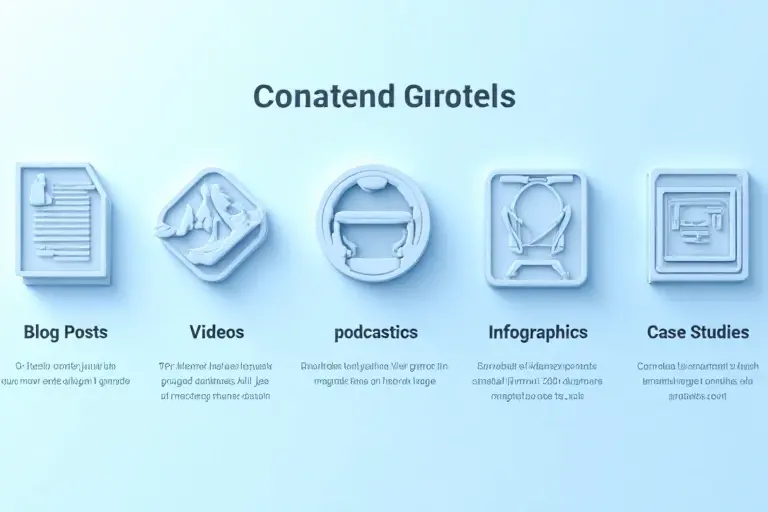
In today's competitive digital landscape, creating an effective content marketing strategy is crucial to attracting, engaging, and retaining your target audience. To ensure your content stands out, it’s important to consider various types of content, distribution strategies, SEO techniques, and the role of storytelling. We will cover everything you need to know to develop a content marketing strategy that drives traffic and boosts conversions.
Content marketing is the creation and distribution of valuable, relevant, and consistent content to attract and engage your target audience. The main objective of content marketing is to provide information that resonates with your audience, helping to build trust and ultimately drive conversions. By focusing on content marketing for retention and customer relationship building, businesses can develop stronger, more lasting connections with their audience.
The core goals of content marketing include:
Creating a content marketing strategy requires planning and foresight. Here’s a step-by-step guide to creating a strategy that aligns with your business objectives:
A solid content marketing strategy will keep you on track and help you stay aligned with your business goals.
Storytelling is one of the most powerful tools in content marketing. By incorporating stories into your content, you can make your brand more relatable and memorable. Brand voice in content plays an important role in storytelling, ensuring your content speaks consistently and authentically to your audience.
Here’s how storytelling can enhance your content:
To create a balanced content marketing strategy, it’s important to leverage a variety of content types. Here are 10 types of content every digital marketer should create:
Each type of content serves a specific purpose, and when combined, they work to create a powerful content marketing strategy.
SEO and content marketing are two sides of the same coin. For your content to be found by your target audience, it needs to be optimized for search engines. A successful content marketing strategy includes proper keyword research, content structure, and on-page SEO techniques to ensure your content ranks well.
Key SEO tips include:
By optimizing your content for search engines, you ensure that your audience can easily find it.
Repurposing content is an efficient way to maximize the value of your work. Rather than creating entirely new content, you can adapt existing content for different formats and platforms. For example:
Repurposing helps you reach a wider audience without reinventing the wheel.
Consistency is key when it comes to content marketing. A content calendar helps you plan and schedule your content in advance, ensuring that you publish regularly. Use a content calendar to:
By staying organized and consistent, you’ll keep your audience engaged and build momentum for your content strategy.
Data and analytics are essential for tracking the success of your content marketing efforts. By measuring key metrics like traffic, engagement, and conversions, you can understand what’s working and refine your strategy accordingly.
Use tools like Google Analytics and social media insights to track performance. Additionally, use data to optimize your content performance analytics and adjust your approach to maximize results.
Social media is a powerful tool for distributing and amplifying your content. Platforms like Instagram, Facebook, and LinkedIn allow you to reach a large audience quickly. To effectively use social media for content marketing:
Social media content writing can help you craft posts that drive engagement and amplify your content’s reach.
A strong brand voice is crucial for creating consistent, authentic content. Your brand voice defines how your company communicates with its audience. To build a strong brand voice:
Companies like Apple and Nike have established strong, recognizable voices that resonate with their customers. By building your own unique voice, you can strengthen your relationship with your audience.
By creating a balanced content marketing strategy that incorporates different content types, you can effectively reach and engage your audience. Optimize your content for SEO, use storytelling to humanize your brand, and amplify your efforts through social media and data analysis. The future of content marketing is bright, and with the right strategy, you can position your brand for long-term success.
What is the best content type for SEO?
Blog posts optimized for SEO in content marketing are ideal for driving organic traffic. Blog writing for SEO helps boost visibility on search engines.
How can I engage my audience with storytelling?
Use storytelling to create emotional connections with your audience, humanize your brand, and share real-life experiences. Brand voice in content is essential to make your storytelling authentic.
What role does data play in content marketing?
Data helps inform your strategy by showing what content performs well and where improvements can be made. Use content performance analytics to measure success.
Can I repurpose content?
Yes, repurposing content into different formats like videos, podcasts, and social media posts can help reach a broader audience without creating entirely new material.
What’s the most effective social media platform for content marketing?
The best platform depends on your audience. Instagram, Facebook, LinkedIn, and Twitter all serve different purposes. Use social media content amplification to boost your content.
How do I create a content marketing budget?
Your budget should cover content creation, distribution, and analytics tools. Prioritize resources based on your goals to maximize ROI.
What is user-generated content?
User-generated content is content created by your audience, such as reviews or social media posts. It’s a great way to build trust and engagement.
How does content marketing help with brand awareness?
Content marketing helps increase visibility and credibility. By producing valuable content consistently, you can build brand awareness through content.
How can I use podcasts for marketing?
Podcasts are a great tool for providing value and reaching your audience in a more personal format. Use them to establish authority and engage listeners.
Why is mobile optimization important for content?
More people access content through mobile devices than ever before. Ensure your content is mobile-friendly to enhance user experience and reach a wider audience.